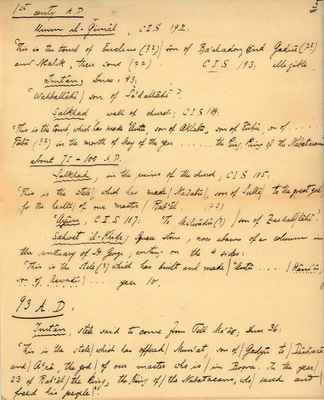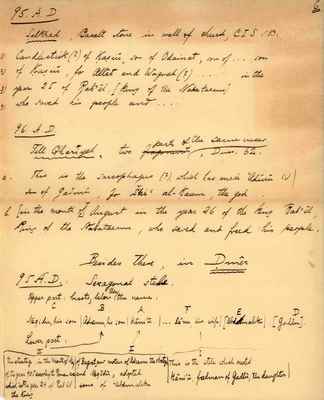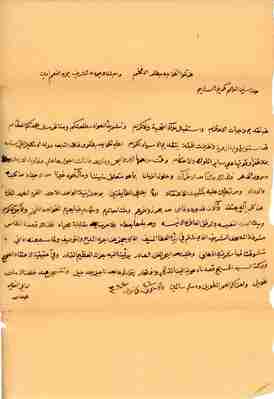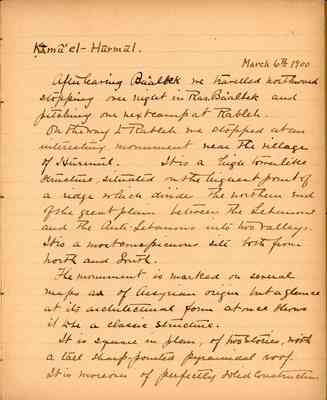Pages
BSY_FB_17-0front_insert6
4.
1 A.D. [Boṣra]], is a modern wall. Duss. 74: ' This whole (?) wall, and the .... / and the cistern (trench ?), which has built Taimū, son of ..../ for Duŝara and the other (??) gods ... '
[ib]]., found in the ruins of a house, near Boṣra CSI 181: ' Sepulchre of 'Obaiŝat Ḳozaḥ. '
[Ezra']], found by Waddington in modern house, CIS 186. Long inscription, translation very uncertain.
'Treh, CIS 189: Illegible fragment.
ib., bull inscription, now in Suwêdā, E.L. 4. : ' Badr and Sa'ad-ĕl, sons of Witrū, friends of Gaddā. Peace! Ḳaṣiū, son of Ḥann'ĕl, artist. Peace! '
Kharabah, Duss. 76: ' 'A[lῑm]at, / wife of / Naŝ['ad]ū. ' Duss 77: ' This is the ... which made 'Anmū / and Ra'û'allâhi, the sons of...'
tell-Gharêyeh, Duss 59: Bilingual 'PaBBἀ / vηs Mo / ∊iθov ' Rabbâ, son of Ko' îtû. '
[Umm il-Gimâl]], Stele 2 metres high; CIS 190: ' Stele, / which has made / Naŝikū / son of 'Awî / dâ for Dûŝarâ. '
ib.; stone in modern wall; CIS 191: ' This tomb of An'am, Son of Kînu, and of 'WEzai his wife, which his built [Hann' êl|Kann' êl] their son. '
BSY_FB_17-0front_insert7
5
Umm il - Ğimâl, CIS 192: ' This is the tomb of Euclinus (??) / son of Ba'aladon, and Jadiū (??) and Malik, their sons (??) ' CIS 193: illegible
Initân, Duss. 43: ' Wahballâhî son of Sa'dallâhî. '
Ṣalkhad, wall of church. CIS 184: ' This is the tomb, which has made 'Autū, son of Aklabû, son of Rûhû, son of ..... Ṭâbâ (??) in the month of May of the year .....the king, King of the Nabataeans '
about 75-100 A.D.
Ṣalkhad, in the ruins of the church; CIS 185: ' This is the stele / which has made / NaŠabû /, son of Šullâ / to the great god /, for the health / of one master /Rab'ĕl. ' (??)
'Ayûn, C.I.S 187: ' To Nilwâdû (?) / son opf Zaidal / lâhî. '
Sahwit il-Khiḍr, Square stone, now abacus of a column in the santuary of St. George, writing on the 4 sides. ' This is the Stele (?) which has built and made / 'Antû ...... / Hâni'û, son of Aswadû / ....year 10. '
93 A.D. Initân, stele said to come from Tell Na'aE; Duss. 36: ' This is the stele / which has offered / Nun'at, son of / Gadyū to / DûŠarâ and / A'râ, the god / of our master who is / in Boṣra. In the year / 23 of Rab'êl / the king, the King of / the Nabataeans, who / saved and / freed his people /. '
BSY_FB_17-0front_insert8
6
95 A.D. Ṣalkhad, Basalt stone in wall of church, CIS 180: 1. Candlestick (?) of Ḳaṣiū, son of Odainat, son of ..., son 2. of Ḳaṣiū, for Allât and Wagrah (?) ... in the 3. year of 25 of Rab'êl, ( King of the Nabataeans ) 4. who saved his people and ...
96 A.D. Tell-Gharîyeh Two ^ parts of the [illegible], Duss. 62: a. This is the sarcophagus (?), which has made 'Adûrû (!) / son of GaŠmû, for Šai' al-Kaum, the god ... b. ( in the month of) August in the year 26 of the King Rab'êl, King of the Nabataeans, who saved and freed his people.
Besides there, in Dmêr 954 A.D. Sexagonal stele
Upper part; busts below them the names:
C |B |A |T |E |D Neqîdû, his son|Adramu, his son|Hâni'û| ..la'nu, his wife| 'Abdmalkiū|(Gadlu)
Lower part:
III. Adramu, his son: (B) the stratege, in the month of May ooof the year 405 according to Roman era which is the year 24 of Rab'êl the King.
II. Hâni'û: (A) of Bagrat, our mother of Adramu the stratege and Neqîdû, adopted son of 'Abdmalkiū.
I. ..la'nu, his wife: (T) This is the stele which erected Hâni'û, freedman of Gadlû, the daughter.
BSY_FB_17-0front_insert9
Arabic text
BSY_FB_17-00
After leaving Ba'albek we traveled northward stopping over night in Ras. Ba'albek and pitching our next camp at Rableh.
On the way to Rableh we stopped at an interesting monument near the village of Hūrmūl. It is a high towerlike structure, situated on the highest point of a ridge which divides the northern end of the great plain between the Lebanons and the Anti-Lebanons into two valleys. It is a most conspicuous site both from North and South.
The monument is marked on several maps as of Assyrian origin but a glance at its architectutal form at once shows it to be a classic structure.
It is square in plan, of two stories, with a tall sharp-pointed pyramidal roof. It is moreover of perfectly solid construction





